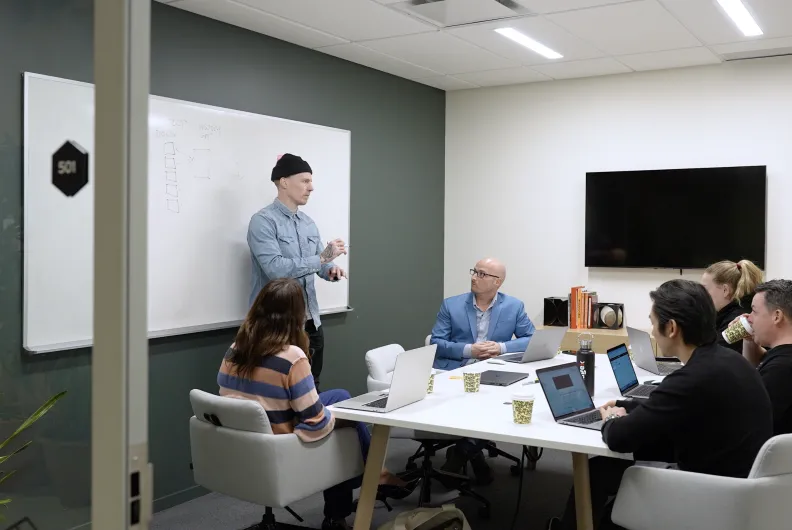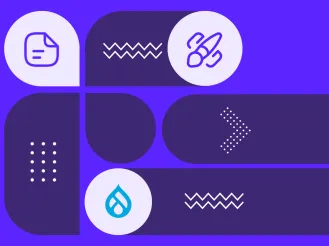Bridging the Gap Between Designers and Developers: Best Practices for Cross-Functional Collaboration
Here's a question that keeps marketing leaders up at night: Why do website projects always seem to go sideways?
Usually, it's because your design team and development team aren't talking to each other. They work in separate worlds, speak different languages, and only discover they're building completely different things when it's too late to fix anything without starting over.
This disconnect creates real problems: miscommunication during handoffs, design concepts that can't be built as envisioned, and endless revision cycles that blow budgets and timelines. Understanding how to bridge this gap can transform your digital projects from sources of frustration into competitive advantages.
What bridging the gap between design and development really means
Everyone talks about "bridging the gap" between design and development, but what does that actually mean? It's not about team building exercises or forcing everyone to be best friends. It's about understanding why these teams can clash in the first place.
Why designers and developers think differently
Designers and developers tend to approach problems from completely different angles. Designers work within user needs, brand guidelines, and project budgets. Developers work within technical limits: platform capabilities, performance requirements, and browser compatibility. They need clear specifications to build stable, maintainable code. There's often friction when these differing constraints collide.
The tension comes from how each discipline solves problems. Designers iterate through options, testing ideas and refining based on feedback. Developers need requirements stable enough to write code that won't need complete rewrites. 92% of developers want designers to understand the development process better, which shows how common this gap really is. Both approaches make sense for their work, but they can clash when teams don't communicate early.
Neither approach is wrong. But when designers don't understand technical constraints, they create concepts that can't be built. When developers don't understand design goals, they build things that technically work but create terrible user experiences.
Neither approach is wrong, they just need to work together from the start.
What happens when teams don't talk to each other
When designers and developers work in isolation, three expensive problems show up:
Designs that blow the budget
Without developer input early, designs might require custom development work nobody budgeted for. Features that looked straightforward in mockups turn out to need significant backend work. Now you're choosing between cutting functionality or going back to stakeholders to explain cost overruns.
Inefficient solutions that create technical debt
When developers don't understand the design goals, they build what's technically easiest rather than what serves users best. The site works, but it's harder to maintain and slower to update. Future changes cost more because the foundation wasn't built with the right priorities.
Endless rework that kills timelines
Designs get built, problems get discovered, and work goes back to square one. Each round trip between teams adds weeks to your launch date. Stakeholders lose confidence and you're stuck fixing preventable problems.
Bridging the gap means getting these teams to understand each other's constraints before anyone commits to a direction. When designers know what's technically feasible within budget, they create smarter concepts. When developers understand what you're trying to achieve for users, they build efficient solutions that work. Everyone wins, and your project doesn't derail.
Why designer-developer collaboration drives business results
You might think collaboration is just about making everyone feel good. When design and development teams work together, you get measurable results that show up on your bottom line.
Projects finish faster when teams work together
80% of developers think their business would benefit from closer collaboration with designers. Teams that work together from the start finish projects faster and need fewer revisions.
Instead of designers creating concepts alone and throwing them over the wall to developers, collaborative teams spot implementation challenges early. Developers can suggest technical approaches that keep the design intact while making it easier to build. Designers can adjust their concepts to work within realistic constraints.
You also stop wasting money on expensive fixes. Think about these scenarios:
- A design concept requires custom development that would double your timeline. Developers suggest alternatives that achieve the same user experience with less development effort
- A technical limitation would create poor user experience. Designers explore different approaches that solve the same user needs
- Scope changes pop up. Both teams evaluate the impact before you approve anything, instead of discovering problems halfway through development
Better websites happen when everyone's on the same page
Good collaboration means everyone understands the answers to five questions before making decisions:
- What does this site need to accomplish for your business?
- What do users actually need to do on it?
- What's the timeline and budget?
- What design approaches will create the right experience?
- What's technically feasible within those constraints?
The answers become your north star for prioritizing what matters and cutting what doesn't. When designers propose an approach, they need to know it fits the technical constraints and budget. When developers build a solution, they need to know it serves the user goals and business objectives. Without this shared understanding, you get designs that can't be built as intended, or technical implementations that miss the point entirely.
The result is websites that accomplish what they're supposed to accomplish. Projects stay on track because everyone understands the constraints upfront. Budgets hold because there are no surprises about what's feasible. Users get experiences that work because both design thinking and technical reality shaped the solution from day one.
Best practices that improve collaboration between design and development teams
You can't just tell teams to "collaborate better" and expect it to work. Instead, frame it as designers and developers working as one team with a shared goal: building something that works for your business and your users. The designer sitting next to the developer in a planning meeting isn't representing "the design team", they're both solving the same problem together, just bringing different expertise to the table.
Here are three practical changes that bridge the gap.
Start with a shared vocabulary
Designers and developers might use different words for the same things. Designers might talk about "hero sections" while developers call them "banners." Designers say "above the fold" while developers think in terms of "viewport height." These differences can create real confusion during project discussions.
Establish one set of terms that both teams use. This happens naturally when you build:
- Style guides that define both visual and technical names for elements
- Component libraries where everyone refers to the same reusable pieces
- Design systems that connect what things look like with how they work
Get developers involved during design
Many project managers bring developers in after designs are "final." That's too late. By then, you've already committed to approaches that might be impossible or expensive to build.
Bring developers into wireframe reviews, not just mockup presentations. They can spot technical issues while you still have flexibility to adjust the approach. A developer might say "that layout won't work on mobile" or "we can achieve that effect in a simpler way". These are insights that save weeks of rework later.
Test ideas before building them
The biggest collaboration hurdle is assumptions. Designers assume developers understand the intended interaction. Developers assume the static mockup shows all the necessary states.
Quick prototypes eliminate these assumptions. Even simple clickable mockups help developers understand user flows without detailed specifications. Tools like Figma let developers inspect designs directly to get exact measurements and specs, so there's no guessing about what designers intended. Weekly check-ins let both teams ask questions before small problems become project roadblocks.
How effective collaboration future-proofs your website
Good collaboration doesn't stop paying off after launch. The decisions teams make together during development determine how your website handles growth, changes, and new features down the road.
Building websites that grow with your business
When design and development plan together from the start, you get websites that can handle whatever comes next. Need to add a new product line? The design system already includes components that work for product pages. Traffic doubled overnight? The technical architecture can handle the load without breaking.
Design systems improve consistency and speed up implementation when you need to add new features or content. Instead of redesigning from scratch every time your business evolves, you can build on what's already there.
Why good teamwork makes maintenance easier
When both teams understand how your website works, changes become straightforward:
- Designers can evaluate proposed changes based on technical complexity rather than visual appeal alone
- Developers can suggest implementation approaches that preserve design consistency while improving performance
- Updates and enhancements happen faster because teams don't need to reverse-engineer previous decisions
Future updates happen faster because nobody needs to reverse-engineer old decisions. Platform migrations go smoother because teams understand both what the site needs to look like and how it needs to function. The best user experiences combine content and design with technical implementation that supports your long-term goals.
How ImageX delivers collaborative web design and development solutions
Most agencies talk about collaboration but still work in silos. Design finishes, then gets handed to development. At ImageX, we’ve built our entire process around eliminating the silos that break projects.
This approach delivers what managing multiple vendors or building in-house teams struggles to achieve: projects that come in on time and on budget while meeting your business goals and user needs.
Here's how we make that happen:
Developers join from day one, not after decisions are made
Our developers participate in discovery meetings with clients. They're helping identify technical opportunities and constraints while requirements are still flexible. This means potential bottlenecks get spotted and solved before anyone commits to an approach that won't work.
When you manage design and development separately, these insights come too late. By the time developers see the plan, you've already made commitments to stakeholders based on assumptions that might not hold up.
Figma keeps everyone working in the same space
Our teams use Figma as a living workspace where designers create, developers inspect specs, and both ask questions in real time. Work gets shown constantly, feedback flows immediately, and nobody waits for formal handoff meetings to discover problems.
This eliminates the translation problems that plague projects with separate vendors. There's no game of telephone where design intent gets lost between teams.
UI kits create blueprints you can build on
We develop UI component kits that both teams work from. Designers know exactly what's buildable, developers know exactly what to implement. These kits become your blueprint for evolving the site after launch. You're not locked into calling us every time you need to add a page that uses existing patterns.
Without this shared foundation, every new feature requires negotiating between designers and developers about what's possible and how it should work.
Internal reviews prevent over-promising
Before we present any milestone to clients, our design and development teams review it together. We validate what's possible, identify the most efficient approach, and make sure we're not promising something we can't deliver on time and budget.
This systematic checkpoint removes bottlenecks before they impact your timeline. When you're coordinating separate vendors, nobody's doing this validation until problems surface mid-project.
Why this beats managing it yourself
Building and maintaining this level of collaboration internally requires dedicated processes, compatible tools, and team members who actively want to work this way. Most organizations struggle to sustain it while also handling their core business.
You get single-point accountability. When something needs adjustment, you know exactly who to call. Projects stay on budget because our team scopes changes together before you approve anything. Your timeline holds because potential problems get identified and solved before they derail progress.
Contact us to explore how ImageX can bridge design and development for your next project.
Contributors









